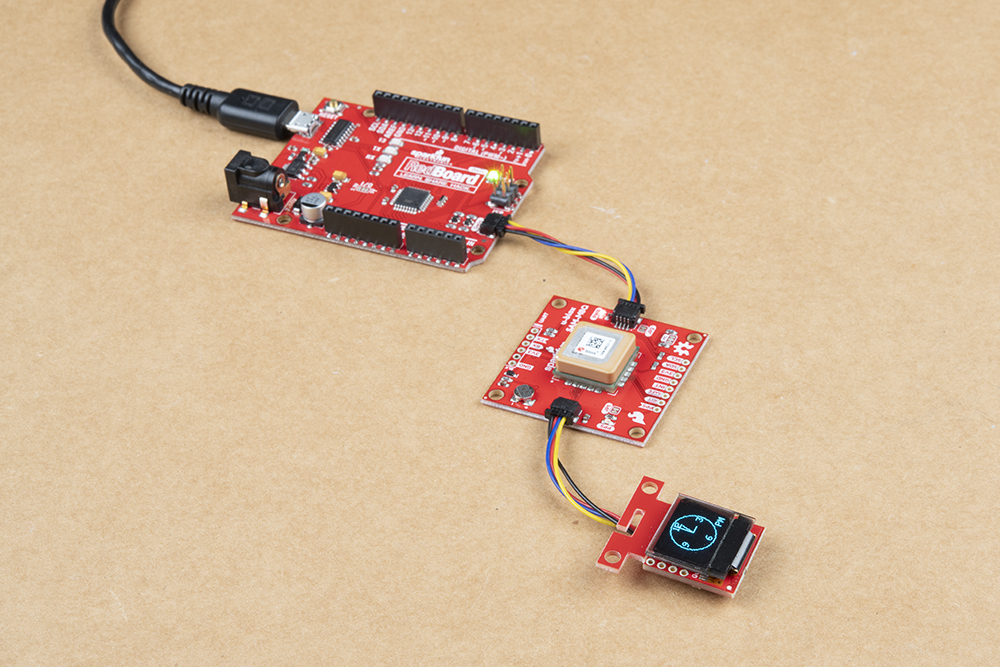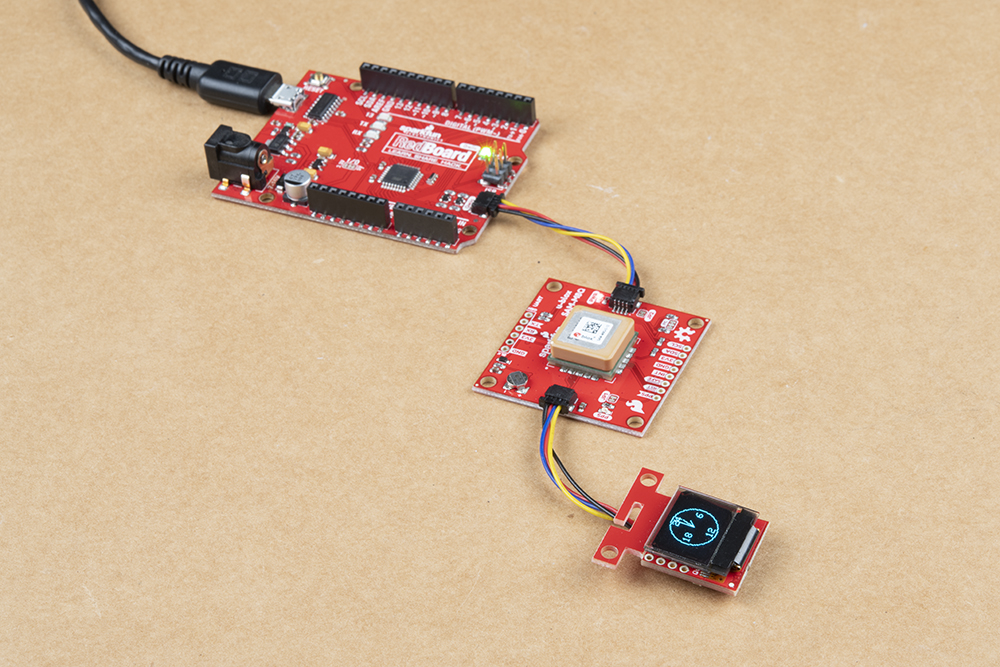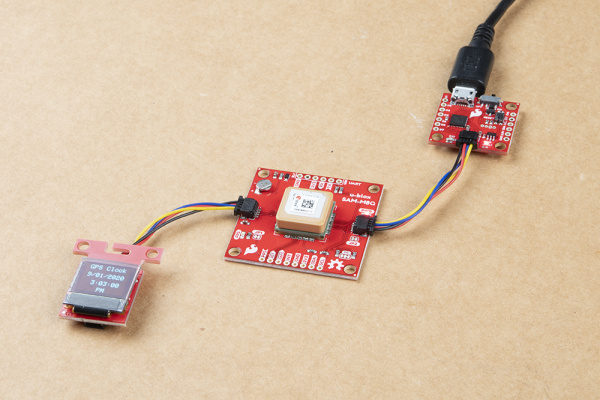Qwiic GPS Clock
Ex 2: Qwiic micro OLED
Based on the template, the following code is adjusted for the Qwiic micro OLED. Besides initializing the I2C port for the Qwiic micro OLED, we simply send data via I2C by each Serial.print() statement. Since there is a dedicated library for the Qwiic micro OLED that opens and closes the I2C bus for each command, we just need to tell the Qwiic micro OLED when to display the date and/or time. Additionally, the Qwiic micro OLED is a bit more flexible in displaying the date and time so we can display it as characters or a graphic.
The trade-off is that it's not as simple as sending characters SerLCD. We'll need to be a bit more specific on where to print and the size of the characters. Another trade-off is that you will need to choose between sending characters to the display or Serial Monitor. This is due to the way the code is written, libraries used, and size of the ATmega328P's RAM.
Required Materials
To follow along with this example, you will need the following materials. You may not need everything though depending on what you have. Add it to your cart, read through the guide, and adjust the cart as necessary.
Additional Suggested Reading
If you decide to use the Qwiic Micro OLED breakout, we recommend taking a look at the following tutorial as well.
Qwiic Micro OLED Hookup Guide
Hardware Hookup
Connecting the boards together is easy. Simply add a Qwiic cable between your Arduino, u-blox GPS module, and the display of your choice. In this case, we used the RedBoard Qwiic with ATmega328P, Qwiic GPS breakout with SAM-M8Q, and Qwiic micro OLED.
Arduino Code
Copy and paste the code in the Arduino IDE. Select the board (in this case the Arduino Uno) and COM port that it enumerated to. Hit the upload button.
language:c
/*
Getting the time and date in your timezone using Ublox commands
Originally Written By: davidallenmann
Modified By: Ho Yun "Bobby" Chan
SparkFun Electronics
Date: April 16th, 2019
License: MIT. See license file for more information but you can
basically do whatever you want with this code.
This is a modified example that shows how to query a Ublox module for the current time and date. We also
turn off the NMEA output on the I2C port. This decreases the amount of I2C traffic
dramatically.
Leave NMEA parsing behind. Now you can simply ask the module for the datums you want!
Additionally, this code has the option to adjust the UTC date and time. The time is adjusted by manually
entering your time zone's offset. The Daylight Savings Time is automatically calculated with the help of
Nathan Seidle's Daylight Savings Time example [ https://github.com/nseidle/Daylight_Savings_Time_Example ].
However, if your country does not observe DST, you can override it with the `enableDST` variable.
The output on the Qwiic microOLED can be in digital or analog form. Depending on personal preference, you can view
the time in regular 12-hour format or miltary 24-hour format. Shout out to Jim for the initial analog clock example code
for 12-hour format! Due to the size of the RAM on the RedBoard Qwiic's ATmega328P, the output to the
Arduino serial monitor is disabled. You can upgrade to the Qwiic Micro with SAMD21 which has been tested
to work with the both. The Qwiic Micro has a bigger RAM so it can handle both outputs.
Feel like supporting open source hardware?
Buy a board from SparkFun!
ZED-F9P RTK2: https://www.sparkfun.com/products/15136
NEO-M8P RTK: https://www.sparkfun.com/products/15005
SAM-M8Q: https://www.sparkfun.com/products/15106
Hardware Connections:
Plug a Qwiic cable into the GPS, Qwiic microOLED, and the RedBoard Qwiic.
If you don't have a platform with a Qwiic connection use the SparkFun Qwiic Breadboard Jumper (https://www.sparkfun.com/products/14425)
*/
#include <Wire.h> //Needed for I2C to GPS
#include "SparkFun_Ublox_Arduino_Library.h" //http://librarymanager/All#SparkFun_Ublox_GPS
#include <SFE_MicroOLED.h> // http://librarymanager/All#Sparkfun_micro_oled_breakout
SFE_UBLOX_GPS myGPS;
long lastTime = 0; //Simple local timer. Limits amount if I2C traffic to Ublox module.
long latitude = 0;
long longitude = 0;
long altitude = 0;
byte SIV = 0;
boolean DST = false; //adjust for Daylight Savings Time, this is calculated automatically. fall back = FALSE, spring forward = TRUE
boolean enableDST = true; //option to disable DST if your country does not observe DST
int zoneOffsetHour = -7; //adjust according to your standard time zone
byte DoW = 0; //needed to adjust hour for DST, or if you want to know the Day of the Week
boolean military = false; //adjust for miltary or AM/PM
boolean AM = false; //AM or PM?
#define PIN_RESET 7 // A pin needs to be declared even though we are not physically connecting to the Qwiic micro OLED via I2C
#define DC_JUMPER 1
MicroOLED oled(PIN_RESET, DC_JUMPER); // I2C declaration
// Use these variables to set the initial time: 3:03:00
int hours = 3;
int minutes = 3;
int seconds = 0;
//Tid Bit: https://www.sparkfun.com/news/2571#yearOrigin
int years = 2003; //year that SparkFun was founded!
int months = 1; //month that SparkFun was founded!
int days = 3; //day that SparkFun was founded!
// How fast do you want the clock to spin? Set this to 1 for fun.
// Set this to 1000 to get _about_ 1 second timing.
const int CLOCK_SPEED = 1000;
unsigned long lastDraw = 0;
// Global variables to help draw the clock face:
const int MIDDLE_Y = oled.getLCDHeight() / 2;
const int MIDDLE_X = oled.getLCDWidth() / 2;
int CLOCK_RADIUS;
int POS_12_X, POS_12_Y;
int POS_3_X, POS_3_Y;
int POS_6_X, POS_6_Y;
int POS_9_X, POS_9_Y;
int S_LENGTH;
int M_LENGTH;
int H_LENGTH;
void setup(){
//Serial.begin(115200);
//while (!Serial)
// ; //Wait for user to open terminal
//Serial.println(F("SparkFun Ublox Example"));
Wire.begin();
Wire.setClock(400000); // Set clock speed to be the fastest for better communication (fast mode)
if (myGPS.begin() == false) //Connect to the Ublox module using Wire port
{
//Serial.println(F("Ublox GPS not detected at default I2C address. Please check wiring. Freezing."));
while (1)
;
}
myGPS.setI2COutput(COM_TYPE_UBX); //Set the I2C port to output UBX only (turn off NMEA noise)
myGPS.saveConfiguration(); //Save the current settings to flash and BBR
oled.begin(); // Initialize the OLED
oled.clear(ALL); // Clear the display's internal memory
oled.display(); // Display what's in the buffer (splashscreen)
delay(1000); // Delay 1000 ms
oled.clear(PAGE); // Clear the buffer.
initClockVariables();
oled.clear(ALL);
drawFace();
drawArms(hours, minutes, seconds);
oled.display(); // display the memory buffer drawn
}
void loop(){
update_Time(); //adjust UTC date/time based on time zone and DST
displayDigital_Date_Time(); //after calculating, display the date and time
//displayAnalog_Time(); //display time
} //end loop
// Simple function to increment seconds and then increment minutes
// and hours if necessary.
void update_Time(){
//Query module only every second. Doing it more often will just cause I2C traffic.
//The module only responds when a new position is available
if (millis() - lastTime > 1000) {
lastTime = millis(); //Update the timer
latitude = myGPS.getLatitude();
longitude = myGPS.getLongitude();
altitude = myGPS.getAltitude();
SIV = myGPS.getSIV();
years = myGPS.getYear();
months = myGPS.getMonth();
days = myGPS.getDay();
hours = myGPS.getHour();
minutes = myGPS.getMinute();
seconds = myGPS.getSecond();
calcZone_DST(); //adjust zone and used to check if it is Daylight Savings Time
}
//Serial.print(F("Lat: "));
//Serial.print(latitude);
//Serial.print(F(" Long: "));
//Serial.print(longitude);
//Serial.print(F(" (degrees * 10^-7)"));
//Serial.print(F(" Alt: "));
//Serial.print(altitude);
//Serial.print(F(" (mm)"));
//Serial.print(F(" SIV: "));
//Serial.print(SIV);
//Serial.println();
}
//Nate's snazzy code!
//Given a year/month/day/current UTC/local offset give me local time
void calcZone_DST() {
//Since 2007 DST starts on the second Sunday in March and ends the first Sunday of November
//Let's just assume it's going to be this way for awhile (silly US government!)
//Example from: http://stackoverflow.com/questions/5590429/calculating-daylight-savings-time-from-only-date
DoW = day_of_week(); //Get the day of the week. 0 = Sunday, 6 = Saturday
int previousSunday = days - DoW;
//DST = false; //Assume we're not in DST
if (enableDST == true) {
if (months > 3 && months < 11) DST = true; //DST is happening!
//In March, we are DST if our previous Sunday was on or after the 8th.
if (months == 3)
{
if (previousSunday >= 8) DST = true;
}
//In November we must be before the first Sunday to be DST.
//That means the previous Sunday must be before the 1st.
if (months == 11)
{
if (previousSunday <= 0) DST = true;
}
}
//adjust time for DST here if it applies to your region
if (DST == true) {//adjust time Daylight Savings Time
hours = hours + 1;
}
else { //leave time as is for Daylight Time
}
//adjust time based on Time Zone
hours = hours + zoneOffsetHour;
//adjust for offset zones when hour is negative value
if (hours < 0) {
days = days - 1;
hours = hours + 24;
}
else if ( hours > 23) {
days = days + 1;
hours = hours - 24;
}
//adjust for AM/PM mode
if (military == false) {
if (hours >= 0 && hours <= 11) {// we are in AM
if (hours == 0) {
hours = 12;
}
AM = true;
}
else { // hours >= 12 && hours <= 23, therefore we are in PM!!!
if (hours > 12 && hours <= 23) {
hours = hours - 12;
}
AM = false;
}
}
/*
Serial.print("Hour: ");
Serial.println(hour);
Serial.print("Day of week: ");
if(DoW == 0) Serial.println("Sunday");
if(DoW == 1) Serial.println("Monday");
if(DoW == 2) Serial.println("Tuesday");
if(DoW == 3) Serial.println("Wednesday");
if(DoW == 4) Serial.println("Thursday");
if(DoW == 5) Serial.println("Friday!");
if(DoW == 6) Serial.println("Saturday");
*/
}
//Given the current year/month/day
//Returns 0 (Sunday) through 6 (Saturday) for the day of the week
//From: http://en.wikipedia.org/wiki/Calculating_the_day_of_the_week
//This function assumes the month from the caller is 1-12
char day_of_week() {
//Devised by Tomohiko Sakamoto in 1993, it is accurate for any Gregorian date:
static int t[] = { 0, 3, 2, 5, 0, 3, 5, 1, 4, 6, 2, 4 };
years -= months < 3;
return (years + years / 4 - years / 100 + years / 400 + t[months - 1] + days) % 7;
}
void displayDigital_Date_Time() {
if (lastDraw + CLOCK_SPEED < millis())
{
lastDraw = millis();
oled.clear(PAGE); // Clear the display, this is already called before we enter this function
oled.setCursor(0, 0); // Set cursor to top-left
oled.setFontType(0); // Smallest font
oled.print(F(" GPS Clock ")); // Print
//Serial.print(F("Date: "));
oled.setCursor(0, 14);
if (months <= 9) {
oled.print(F(" ")); // Print
//Serial.print(F(" "));
}
oled.print(String(months) + '/');
//Serial.print(String(months) + '-');
if (days <= 9) {
oled.print(F("0")); // Print
//Serial.print(F("0"));
}
oled.print(String(days) + '/' + String(years));
//Serial.println(String(days) + '-' + String(years));
//Serial.print(F("Time: "));
oled.setCursor(3, 28);
oled.print(" ");
if (hours <= 9) {
oled.print(' ');
//Serial.print(' ');
}
oled.print( String(hours) + ':' );
//Serial.print(String(hours) + ':' );
if (minutes <= 9) {
oled.print(F("0"));
//Serial.print(F("0"));
}
oled.print(String(minutes) + ':' );
//Serial.print(String(minutes) + ':');
if (seconds <= 9) {
oled.print(F("0"));
//Serial.print(F("0"));
}
oled.print(String(seconds));
//Serial.print(String(seconds));
oled.setCursor(27, 40);
if (military == false) {
if (AM == true) {
oled.print(F("AM"));
//Serial.println(F(" AM"));
}
else {
if (AM == false) {
oled.print(F("PM"));
//Serial.println(F(" PM"));
}
}
}
else {
//Serial.println(F("")); //space between military time for Serial Monitor
}
if (myGPS.getDateValid() == false) {
oled.setCursor(0, 40);
oled.print(F("!D"));
//Serial.println(F("Date is invalid, not enough satellites in view!"));
}
if (myGPS.getTimeValid() == false) {
oled.setCursor(53, 40);
oled.print(F("!T"));
//Serial.println(F("Time is invalid, not enough satellites in view!"));
}
oled.display(); // Update the display
//Serial.println();
}
}
void initClockVariables() {
// Calculate constants for clock face component positions:
oled.setFontType(0);
CLOCK_RADIUS = min(MIDDLE_X, MIDDLE_Y) - 1;
POS_12_X = MIDDLE_X - oled.getFontWidth();
POS_12_Y = MIDDLE_Y - CLOCK_RADIUS + 2;
POS_3_X = MIDDLE_X + CLOCK_RADIUS - oled.getFontWidth() - 1;
POS_3_Y = MIDDLE_Y - oled.getFontHeight() / 2;
POS_6_X = MIDDLE_X - oled.getFontWidth() / 2;
POS_6_Y = MIDDLE_Y + CLOCK_RADIUS - oled.getFontHeight() - 1;
POS_9_X = MIDDLE_X - CLOCK_RADIUS + oled.getFontWidth() - 2;
POS_9_Y = MIDDLE_Y - oled.getFontHeight() / 2;
// Calculate clock arm lengths
S_LENGTH = CLOCK_RADIUS - 2;
M_LENGTH = S_LENGTH * 0.7;
H_LENGTH = S_LENGTH * 0.5;
}
// Draw the clock's three arms: seconds, minutes, hours.
void drawArms(int h, int m, int s) {
double midHours; // this will be used to slightly adjust the hour hand
static int hx, hy, mx, my, sx, sy;
// Adjust time to shift display 90 degrees ccw
// this will turn the clock the same direction as text:
if (military == true) {
h -= 6;
}
else {//military == false, i.e. 12 mode
h -= 3;
}
m -= 15;
s -= 15;
if (h <= 0) {
if (military == true) {
h += 24;
}
else {
h += 12;
}
}
if (m < 0)
m += 60;
if (s < 0)
s += 60;
// Calculate and draw new lines:
s = map(s, 0, 60, 0, 360); // map the 0-60, to "360 degrees"
sx = S_LENGTH * cos(PI * ((float)s) / 180); // woo trig!
sy = S_LENGTH * sin(PI * ((float)s) / 180); // woo trig!
// draw the second hand:
oled.line(MIDDLE_X, MIDDLE_Y, MIDDLE_X + sx, MIDDLE_Y + sy);
m = map(m, 0, 60, 0, 360); // map the 0-60, to "360 degrees"
mx = M_LENGTH * cos(PI * ((float)m) / 180); // woo trig!
my = M_LENGTH * sin(PI * ((float)m) / 180); // woo trig!
// draw the minute hand
oled.line(MIDDLE_X, MIDDLE_Y, MIDDLE_X + mx, MIDDLE_Y + my);
if (military == true) {
midHours = minutes / 6.0; // midHours is used to set the hours hand to middling levels between whole hours
h *= 10; // Get hours and midhours to the same scale
h += midHours; // add hours and midhours
h = map(h, 0, 24, 0, 360); // map the 0-24, to "360 degrees"
h = h / 10;
}
else {
midHours = minutes / 6.0; // midHours is used to set the hours hand to middling levels between whole hours
h *= 10; // Get hours and midhours to the same scale
h += midHours; // add hours and midhours
h = map(h, 0, 12, 0, 360); // map the 0-12, to "360 degrees"
h = h / 10; //scale back down
}
hx = H_LENGTH * cos(PI * ((float)h) / 180); // woo trig!
hy = H_LENGTH * sin(PI * ((float)h) / 180); // woo trig!
// draw the hour hand:
oled.line(MIDDLE_X, MIDDLE_Y, MIDDLE_X + hx, MIDDLE_Y + hy);
}
// Draw an analog clock face
void drawFace() {
// Draw the clock border
oled.circle(MIDDLE_X, MIDDLE_Y, CLOCK_RADIUS);
if (military == false) {
// Draw the clock numbers for 12-hour mode
oled.setFontType(0); // set font type 0, please see declaration in SFE_MicroOLED.cpp
oled.setCursor(POS_12_X, POS_12_Y); // points cursor to x=27 y=0
oled.print(12);
oled.setCursor(POS_6_X, POS_6_Y);
oled.print(6);
oled.setCursor(POS_9_X, POS_9_Y);
oled.print(9);
oled.setCursor(POS_3_X, POS_3_Y);
oled.print(3);
}
else {
// Draw the clock numbers for 24-hour mode
oled.setFontType(0); // set font type 0, please see declaration in SFE_MicroOLED.cpp
oled.setCursor(POS_12_X, POS_12_Y); // points cursor to x=27 y=0
oled.print(24);
oled.setCursor(POS_6_X - 3, POS_6_Y);
oled.print(12);
oled.setCursor(POS_9_X, POS_9_Y);
oled.print(18);
oled.setCursor(POS_3_X - 3, POS_3_Y);
oled.print(F("6"));
}
}
void displayAnalog_Time() {
// Check if we need to update seconds, minutes, hours:
if (lastDraw + CLOCK_SPEED < millis())
{
lastDraw = millis();
// Draw the clock:
oled.clear(PAGE); // Clear the buffer
drawFace(); // Draw the face to the buffer
drawArms(hours, minutes, seconds); // Draw arms to the buffer
oled.setFontType(0); // Smallest font
oled.setCursor(52, 40);
if (military == false) {
if (AM == true) {
oled.print(F("AM"));
//Serial.println(F(" AM"));
}
else {
if (AM == false) {
oled.print(F("PM"));
//Serial.println(F(" PM"));
}
}
}
if (myGPS.getTimeValid() == false) {
oled.setCursor(0, 40);
oled.print(F("!T"));
//Serial.println(F("Time is invalid, not enough satellites in view!"));
}
oled.display(); // Draw the memory buffer
}
}
The code in this example is based of the template. By default, the Qwiic micro OLED will display the time and date in digital form with 12-hour format. The time zone is set to Mountain Time with DST enabled. To switch to analog clock, you'll need to add a single line comment using the // syntax before displayDigital_Date_Time(); and removing the single line comment before the displayAnalog_Time();. To switch from AM/PM to military format, you will need to set military to true. Depending on your region, you will need to adjust the enableDST and zoneOffsetHour accordingly for your region. You will also need to adjust the condition statements at the beginning of the calcZone_DST() function for region since the DST starts/ends on different days of the month.
After uploading, the micro OLED will display either digital or analog. Depending on your personal preference, it may display the time as either AM/PM or military.
"Low memory available, stability problems may occur"Unfortunately, this is one of those times where you will need to decide between using either the Qwiic micro OLED or the Arduino Serial Monitor when viewing the time or date. This is due to the way the code is written, libraries used, and the ATmega328P's RAM. By default, the code comments out all the `Serial.print()` functions so that we can display the clock using the Qwiic micro OLED. You'll need to comment out any instance of the micro OLED library being used and uncomment any instance of the `Serial` library before viewing the messages in the Arduino Serial Monitor. You could use the conditional
#if preprocessor directives to wrap the instances but it would get messy if you needed to switch to Serial to debug code. While the code implemented the
F() macro to help reduce the size of RAM used, more work would be needed to get the micro OLED and Serial libraries to compile together. One option may be to start with the global variables and scoping them out for each function. You could also attempt to adjust the data types to save some space. If you decide that you want a smaller microcontroller with more RAM, you could use the Qwiic Micro with the SAMD21. You will just need to make sure to install the SAMD21 board add-on in the Arduino IDE to be able to compile code for the Qwiic micro OLED and the Serial Monitor.





